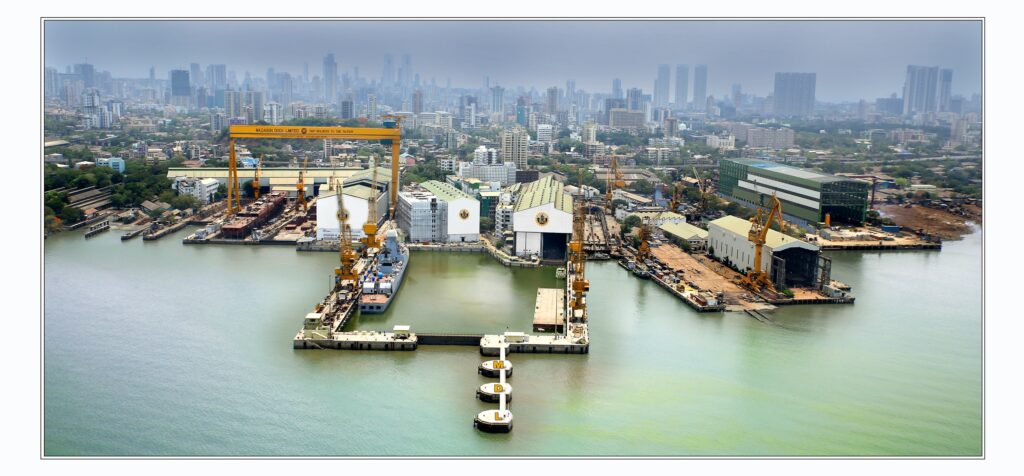The investments in high-capacity ports, green mobility, tourism, energy, shipping security, and shipbuilding can generate more than 150,000 direct and indirect jobs across various states.
On September 19, 2025, Bhavnagar, Gujarat, hosted the “Samudra Se Samriddhi” MoU Exchange Ceremony, focusing on India’s maritime sector. The Prime Minister addressed the event, where 27 maritime projects were exchanged between public and private stakeholders. Union ministers, Sarbananda Sonowal, Dr Mansukh Mandaviya, and Shantanu Thakur were also present. Together, these agreements carry an investment and development potential of over ₹66,000 crore and represent a significant collaborative commitment towards the growth of India’s maritime and shipbuilding sector. With commitments exceeding ₹66,000 crore, the projects encompass high-capacity ports, green mobility, tourism, energy, shipping security, shipbuilding ecosystems, and strong financial capital frameworks.

The MoU ceremony showcased India’s integrated vision for maritime growth, covering new port infrastructure, shipping, shipbuilding clusters, global shipyard partnerships, financing mechanisms, innovative maritime investment, sustainable projects such as water metros and green tugs, as well as heritage-linked initiatives like the lighthouse museum. These projects will collectively reshape India’s industrial, socio-economic, and strategic landscape, positioning the nation as a premier global maritime and shipbuilding hub within the next decade, in line with the vision of an Atmanirbhar Bharat.
A landmark MoU was signed between Paradip Port Authority, Visakhapatnam Port Authority, Sagarmala Finance Corporation, and the Government of Odisha for the development of a new port at Bahuda, with a capacity of 150 million tonnes per annum proposed to be developed on more than 6,700 acres of coastal salt land that have been designated for maritime use, this project is expected to attract an investment of around ₹21,500 crore. It will act as an anchor for port-led industrialisation, logistics parks, and manufacturing clusters across Odisha and northern Andhra Pradesh. The Port is expected to provide direct and indirect employment opportunities to nearly 25,000 people while catalysing new waves of industrial and infrastructure development in eastern India.
On the shipping front, a significant step towards India’s energy independence was unveiled through the MoU between the Shipping Corporation of India and the Oil PSUs—IOCL, BPCL, and HPCL—for the creation of a Vessel Owning Joint Venture Company. This is the first in a series of steps that will pool vessel demand from energy PSUs, thereby reducing reliance on foreign shipping fleets. It will also ensure long-term charter contracts for Indian-built ships, supported by SCI’s regulatory and operational expertise. The MoU aims to secure India’s vital crude oil and product transportation chains while scaling up demand for Indian shipbuilders in tandem with the Government’s Atmanirbhar Bharat programme.

Another category of MoUs at the ceremony related to shipbuilding and its related clusters. In a move that could significantly alter the global perception of India’s shipbuilding capabilities, the Ministry facilitated MoUs between major ports under the MoPSW, GOI, and the State Governments of Andhra Pradesh, Odisha, Gujarat, Maharashtra, and Tamil Nadu to initiate the development of shipbuilding clusters. These will be organised through SPVs with joint investments from the central and state governments, supported by land transfers at minimal cost, tax incentives, and supportive policy measures. The ceremony also included collaborations between the Indian industry and international partners. A notable MoU was signed between Cochin Shipyard (CSL) and HD Korea Shipbuilding and Offshore Engineering, marking a long-term strategic partnership to build large commercial vessels in India. The 310-metre Dry Dock facility at Cochin Shipyard, inaugurated by the Prime Minister in January 2024, is now operational.
The partnership will enable India to build large carriers, including Suezmax oil tankers, container ships, and bulk carriers, with an annual capacity of up to six ships. CSL has announced plans for an 80-acre Block Fabrication Facility (BFF) in Kochi. The investment is approximately ₹3,700 crore, with an annual throughput potential of 120,000 metric tonnes of steel fabrication. The plant will create about 2,000 direct jobs and several times more indirect employment in allied industries, especially MSMEs and supply chains.
CSL also signed an MoU with SIPCOT and Guidance Tamil Nadu for the creation of a shipbuilding complex worth ₹15,000 crore in the state. The facility will have a unique capacity to manufacture one million GT of ships annually and will generate employment for around 8,000 people directly and over 40,000 indirectly. Mazagon Dock Shipbuilders Limited entered into a parallel MoU with Guidance Tamil Nadu to set up another large greenfield yard in Thoothukudi.
Atmanirbhar telecom
New-Gen Swadeshi telecom revolution
Beyond India’s earlier dependence on foreign-supported 2G, 3G, and 4G services, India developed 4G and 5G with the Atmanirbhar spirit. Research and innovation supported by the Telecom Technology Development Fund will solidify India’s swadeshi position in 5G and 6G.
India has launched its first fully indigenous 4G (5G-ready) network and the commissioning of nearly 98,000 Swadeshi 4G towers, all powered by homegrown technology. The core network, created by C-DOT and integrated with Tejas Networks’ Radio Access Network by TCS, showcases a significant technological advancement embodying the spirit of Atmanirbhar.
Previously reliant on foreign technology for telecom services such as 2G, 3G, and 4G, India took decisive action during the Covid-19 pandemic by developing a completely indigenous 4G stack from the ground up, showcasing resilience, rapid innovation, and supply chain independence. This achievement has positioned India among five nations capable of launching fully homegrown 4G services, thereby reinforcing the spirit of ‘swadeshi’. BSNL’s cloud-native, 5G-ready 4G stack ensures immediate connectivity while enabling seamless upgrades, nurturing domestic talent, and strengthening supply chains. Complementary government initiatives, including the Bharat 6G Alliance, 100 5G/6G labs, and the Telecom Technology Development Fund, are advancing research and innovation, charting a path toward Viksit Bharat 2047 and global leadership in digital technology.
The successful deployment of indigenous 4G technology and the expansion of 5G will accelerate digital connectivity, strengthening India’s telecom ecosystem for future advancements. India launched 5G services on 1st Oct 2022. Within eight months, 2,00,000 sites covering 700 districts were established, and subsequently, 5G networks were rolled out in all 28 states and eight UTs. India experienced one of the fastest 5G rollouts in the world. As of now, telecom service providers (TSPs) have installed nearly half a million 5G Base Transceiver Stations (BTSs). The launch of 5G has benefited various sectors, including agriculture, healthcare, education, manufacturing, smart cities, automotive, transportation, media, and entertainment.
Highlight
Agriculture: 5G will empower precision farming and smart agriculture with real-time data from IoT sensors and drones, with AI for enhanced productivity and resource management.
Automotive and transport: 5G will facilitate connected and autonomous vehicles, real-time traffic updates, and safer road transport systems.
Education: Enhanced virtual classrooms and immersive augmented/virtual reality (AR/VR) experiences will improve remote learning opportunities.
Entertainment and media: Enhanced high-definition streaming, immersive gaming, and interactive media experiences will be possible.
Healthcare: 5G will enable telemedicine, remote diagnostics, and real-time health monitoring, improving healthcare access, especially in rural areas.
Manufacturing and industry: 5G will support automation, robotics, and smart factories with ultra-reliable, low-latency communication for increased efficiency and safety.
Smart cities: 5G will help intelligent traffic management, energy-efficient infrastructure, public safety, and environmental monitoring through connected devices.
BOX
Stepping stone to 6G
Bharat 6G Vision envisages India to be a frontline contributor in the deployment of 6G technology by 2030.

The rapid rollout and domestic adoption of 5G are laying the foundation for India’s Bharat 6G Mission, positioning the country as a global leader in future telecom innovation.Currently, the 6G technology is in the development phase at the international level and is expected to be available by 2030. Bharat 6G Vision envisages India to be a frontline contributor in the design, development and deployment of 6G technology by 2030.
Bharat 6G Vision is based on principles of affordability, sustainability and ubiquity (universality). The Department of Telecom has facilitated the setting up of ‘Bharat 6G Alliance’, which is an alliance of domestic industry, academia, national research institutions and standards organisations to develop an action plan according to the Bharat 6G Vision.

